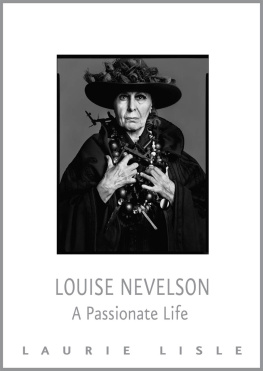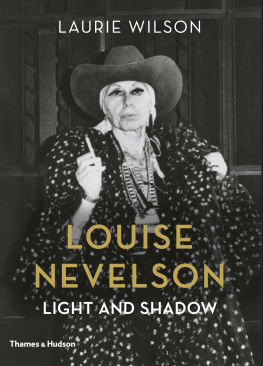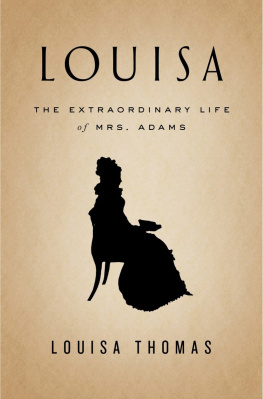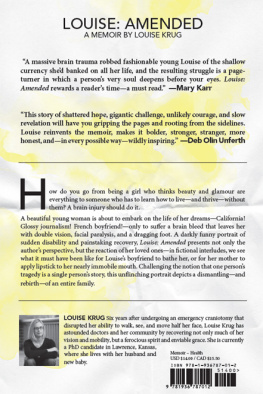ALSO BY LAURIE LISLE
PORTRAIT OF AN ARTIST:
A B IOGRAPHY OF G EORGIA OK EEFFE
WITHOUT CHILD:
C HALLENGING THE S TIGMA OF C HILDLESSNESS
FOUR TENTHS OF AN ACRE:
R EFLECTIONS ON A G ARDENING L IFE
WESTOVER:
G IVING G IRLS A P LACE OF T HEIR O WN
L OUISE N EVELSON
A Passionate Life
Laurie Lisle
All rights reserved, including without limitation the right to reproduce this ebook or any portion thereof in any form or by any means, whether electronic or mechanical, now known or hereinafter invented, without the express written permission of the publisher.
Originally published by Summit Books.
Copyright 1990, 2001 by Laurie Lisle
ISBN: 978-1-5040-3061-8
Distributed in 2016 by Open Road Distribution
180 Maiden Lane
New York, NY 10038
www.openroadmedia.com

Acknowledgments
Scores of Louise Nevelsons family members and friends agreed to be interviewed for this biography, and my thanks go to each one of them. The book has been immensely enriched by the memories of her schoolmates in Rockland, Maine, especially Florence Flynn Snow; her Nevelson and Berliawsky relatives, particularly Corinne Nevelson and Lillian Mildwoff Berliawsky; her granddaughters, notably Neith Nevelson; artists who knew her at the Art Students League and during the Works Progress Administration, especially Dorothy Dehner; art critics and museum officials, particularly Dorothy Miller; and studio assistants, notably Diana MacKown. Arnold Glimcher of the Pace Gallery provided invaluable assistance. I am most grateful of all to Louises son, Mike Nevelson, for the many hours he spent with me and for his permission to quote for the first time from his numerous letters to his mother. Special thanks go to her sister, Anita Berliawsky Weinstein, and deep gratitude to Abram Chasins, Alice Neel, Hubert Crehan, and others too numerous to name. I am indebted to Suzanne Bloch for allowing me to publish extraordinary passages about Louise from the diary of her father, composer Ernest Bloch. I also wish to thank my friend Sherry Huber for her insights into the manuscript and my agent, Charlotte Sheedy, and editor, Anne Freedgood, for their professional dedication to the biography. Finally I wish to thank staff members at the libraries of the Whitney Museum of American Art, the Museum of Modern Art, the YIVO Institute for Jewish Research, the New York Public Library, the Archives of American Art in New York and Washington, D.C., and at the William A. Farnsworth Library and Art Museum in Rockland.
Introduction
LOUISE NEVELSONS life was the quintessential American success storyan immigrant invents a new identity for herself and achieves fame in the New World. She was uprooted twice, first from tsarist Russia in early childhood, then from Maine in 1920 when she left for New York as a young bride. Her artistic maturity coincided with the blossoming of American art in the midtwentieth century, and although she was never embraced by any aesthetic movement, by the end of her life she was regarded as integral to the renaissance of American sculpture, and her work was in the collections of the worlds major museums.
Throughout her career, her beauty and flamboyance made it difficult for many people to take her seriously as an artist. She was often depressed or enraged as she struggled to exhibit and sell her work. Yet while she attacked the art world for being male-dominated, she saw herself as uniquenot a model for other women. In a desperate effort to gain control over her life, she molded the meaning of femininity to her will. Although she got more gratification from art than from motherhood, she suffered intense, lifelong conflict and guilt about her son.
She never entirely lost her bewildering sense of being simultaneously inferior and superior to everyone around her because of being an outsider in New England of extraordinary beauty, energy, and talent. For years she led a kind of Cinderella existence, making forays into the worlds of the rich and fashionable and returning to her under heated studio and empty refrigerator. Her public face was carefully cultivated to hide the seriousness of her private one, and its glamour helped to promote her career.
The difficulty and demands of an artists life exaggerated her assumption that others should serve her. And indeed it was only after she had the help of assistants and developed an obsessed absorption in her work that she began to achieve her artistic triumphs. She survived and flourished as an artist because of her bravado, nerve, charm, shrewdness, and sheer unmitigated ability, observed an old friend. By the end of her life she had reinvented herself through her creative imagination.
I first became aware of Nevelsons work during the early 1970s, when I walked through Central Park to work in midtown Manhattan each morning. I enjoyed encountering her towering steel Night Presence IV at the southeast corner of the park. The contradiction between her work and her persona interested methe assertive steel sculptures which demolished old assumptions about the work of women artists and her lavish ultra feminine presentation of herself.
After deciding that I wanted to write her biography, I went to see her on a warm, sunny day in April, 1982. I had made an appointment, but when I rang the bell next to the ornate metal door at 29 Spring Street, the main entrance to her establishment of interlocking buildings in SoHo, no one answered. I waited a few minutes, then telephoned her son and her gallery; they both informed me that she was not ill and always kept appointments. As I stood on the doorstep pondering what to do next, a delivery boy told me to try the studio, behind a screen door a few feet away. I knocked, and from a shadowy interior a tall woman with high cheekbones looked up, startled. When I reminded her of our appointment, she consulted with someone else and told me it had been forgotten; she asked me to come back in ten minutes.
When I returned, she had pulled an old knitted cap over her cropped gray hair and thrown on a richly embroidered kimono, which opened to show little wooden finials in the pocket of her denim shirt underneath. A huge stuffed black panther, a black cat, and a number of black sculptures as powerful as fetishes were in the room. There were no false eyelashes or mascara on her glowing dark eyes, and her smile was radiant. She began to talk in a husky voice marked by the flat vowels of Maine and the staccato rhythms of Manhattan in a kind of stream-of-consciousness that abruptly leaped from philosophical pronouncements to intimate, revealing remarks. I became interested in writing a biography that concentrated on the circumstances and forces that motivated her to create art, rather than on the massive oeuvre itself, partly because so much has been written about her widely displayed sculpture and so little about her extraordinary life.
Biographers of artists face special difficulties: their subjects are often inarticulate, and their verbal utterances are apt to be suspect or inadequate. Although Nevelson gave many boxes of her papers to several archives, they contain little written in her own hand except sparse journal entries, checkbook notations, drafts of speeches, and enigmatic poems and essays about art. She wrote relatively few letters during her lifetimeusually only a few misspelled words in a large, childish script on a postcardbecause, she explained to me, she never felt secure enough to write things down. Her son told me that she deliberately created misinformation, putting down the wrong date or signing her name Louise Neverlands, because she did not want to be pinned down to the reality of the words. Her mistrust of the written word was so great that she usually picked up the telephone when she wanted to express herself to someone.











